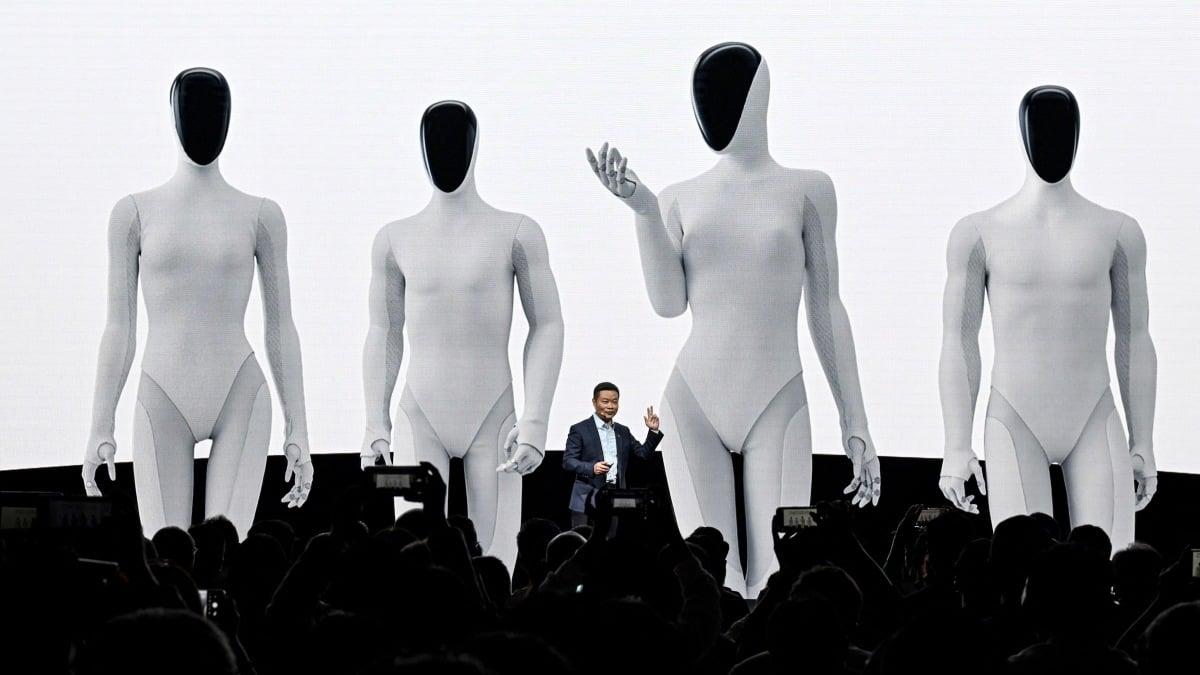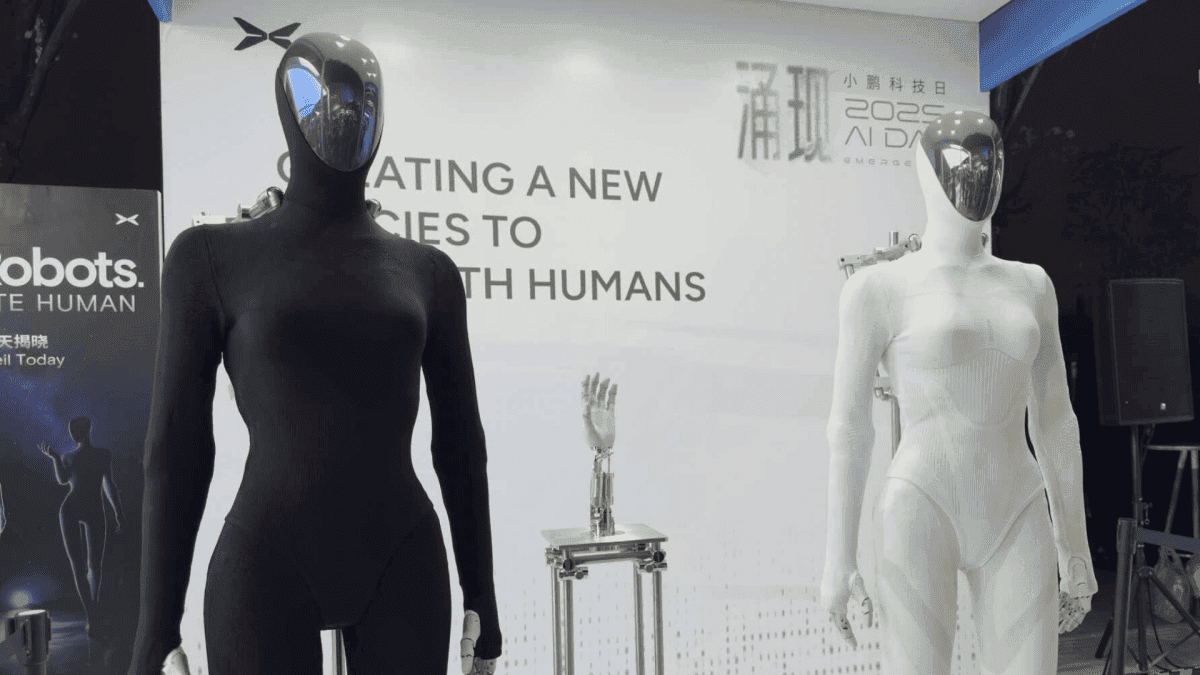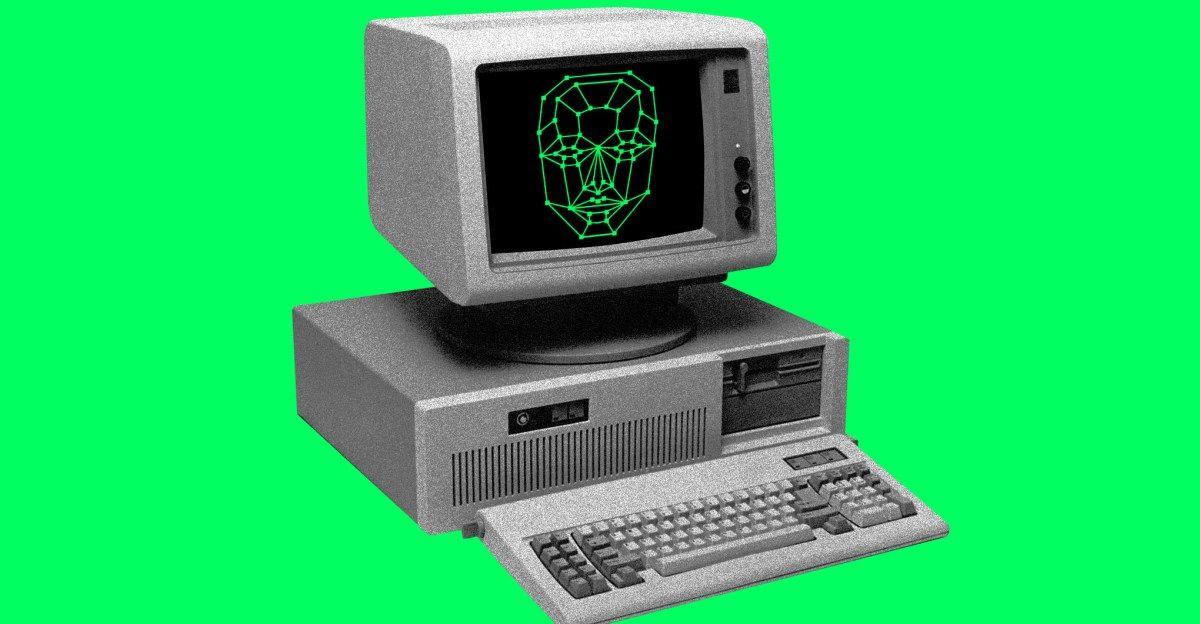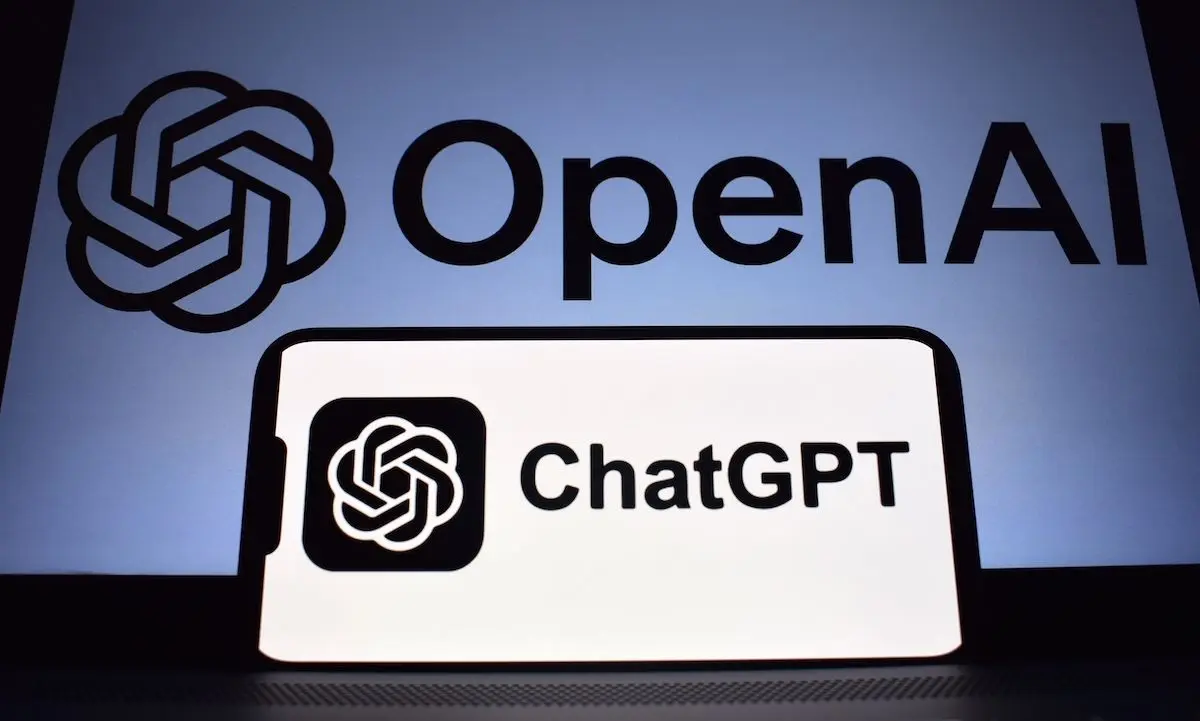Xpeng's IRON Humanoid Robot Sparks Global Attention with Lifelike Movement and Controversial Design
5 Sources
5 Sources
[1]
Watch: Chinese company's new humanoid robot moves so smoothly, they had to cut it open to prove a person wasn't hiding inside
Chinese electric vehicle (EV) maker Xpeng has unveiled a new humanoid robot with such lifelike movements that company representatives felt compelled to slice it open onstage to prove a human wasn't hiding inside. Fortunately for the audience, there wasn't. Instead, the robot, named "IRON," features a flexible, humanlike spine, articulated joints and artificial muscles that allow it to move with a model-like swagger. This is thanks to Xpeng's custom artificial intelligence (AI) robotics architecture, which enables it to interpret visual inputs and respond physically without needing to first translate what it sees into language. Speaking during IRON's unveiling at Xpeng's AI Day in Guangzhou on Nov. 5, China, He Xiaopeng, chairman and CEO of Xpeng Motors, suggested that IRON's appearance was designed to be recognizably human -- if slightly unsettling. The machine is equipped with 82 degrees of freedom, including 22 in each hand, allowing it to bend, pivot and gesture at multiple points throughout its body, representatives said in a statement. It's powered by three custom AI chips that give it a combined 2,250 trillion operations per second (TOPS) of computing power, which Xpeng says makes it one of the most powerful humanoid robots developed to date. For comparison, Intel's Core Ultra 200V series processor, fitted into some of the best laptops, can achieve just 120 TOPS. IRON is based on what its creators call a "born from within" design, a concept that reflects the robot's design mimicking the human body from the inside out. The robot features an internal endoskeleton and bionic muscle structure capable of supporting different body types, ranging from slim to stocky, which users can customize. Its outer layer is also made from "full-coverage" synthetic skin, He said during the presentation, making the robot "feel warmer and more intimate." "The next generation has very flexible bones, solid bionic muscles, and soft skin. We hope it can have a similar height and proportions to human beings," He said. "In the future, robots will be life partners and colleagues. I suspect that, just like when you buy a car, you can choose different colors, exteriors, and interiors. In the future, when you buy a robot, you can choose the sex, hair length, or clothing for your desired purpose." According to Xpeng, IRON is also the first humanoid robot in the world to run on an all-solid-state battery. Solid-state batteries use ceramics or polymers instead of the flammable liquids in conventional lithium-ion batteries, making them safer for the enclosed environments where the robot is designed to operate. IRON is destined for mass production, although Xpeng ruled out household chores for the immediate future, pointing out that a humanoid robot operating in messy or unpredictable households could pose safety risks. Instead, it will debut in commercial settings such as stores, offices and company showrooms, with the first models expected to appear in Xpeng locations in 2026. The announcement forms part of Xpeng's broader push into "physical AI," which aims to bring together robotics, autonomous vehicles and AI development under a unified platform. Earlier this year, the company revealed a prototype flying car designed to launch from a Cybertruck-style mobile base. Humanoid robots have been having something of a moment in recent months. In October, Chinese robotics startup Unitree debuted its pirouetting, karate-kicking H2 model. Unlike IRON, Unitree's bot has yet to be given an official release date, meaning Xpeng's bot may well beat it to the shop floor (or office reception).
[2]
XPENG's new humanoid robot has breasts. Here's why.
Chinese EV company XPENG unveiled its next-gen humanoid robot IRON during its AI Day event in Guangzhou, having it walk onto the stage in a stilted yet strangely lifelike saunter. The reveal swiftly sparked online discussion concerning the IRON's distinctly feminine appearance and walk, XPENG having equipped its robot with wide hips and notable breasts. However, while this seemed like a strange design decision to some, XPENG does have reasons for modelling its IRON robot on a woman. Addressing the IRON's form factor during his keynote speech, XPENG's chairman and CEO Xiaopeng He first explained why the company's robots are humanoid at all. He stated that he'd been insistent on quadruped robots during the company's first forays into robotics, as four legs are more stable than two. However, quadrupeds lack the functionality of hands, and have trouble navigating smaller spaces due to difficulty in turning around. As such, while he believes future advanced robots will come in many different humanoid and non-humanoid shapes, the former is the most practical design at this stage. "A lot of scenarios are designed for human beings in this world," said He, later speaking to the media via a translator. "If the robot is more human-like then it's [easier for] them to adapt to the real world." He also considered that humanoid robots elicit a more emotional reaction from consumers, as they feel more friendly and inviting than other potential forms. "More human-like robots and also non human-like robots can both be good looking, but the human-like robot can be more intimate," He continued. "If you think it's warmer, more human, then you can sell more and you can reach the scale effect, then the cost control can be better in return. It will have actually a positive cycle." Considering XPENG's mission to create human-like robots, the next-gen IRON's curvier build shouldn't be too surprising. Liangchuan "LC" Mi, vice president of XPENG's Robotics Centre, told reporters that the company chose to create a female-presenting robot simply because there are female-presenting people. "This is more about inspiration," said Mi. "We see the different options because there are different kinds of humans. So we're trying to see how people can react [to different form factors].... So we'll see all kinds of feedback from people, and people may have different preferences when they put the robot into the workforce." "The head of our Robotics Centre, he said, 'We are not making robots. We are making humans,'" XPENG's CEO He said during his keynote speech. "In the future, robots will be [your] life partners and also maybe your colleagues. That's why it's more like [an] intelligent human, [and] has the intelligence to create a better life with human beings." He therefore hopes to make IRON as close to human as possible, including giving it soft skin, a height similar to that of a human, and secondary sex characteristics. "It can be more like [a] human, with different body shapes," said He. "You can choose a little bit fatter IRON, or, like me, a slimmer IRON. Or you can customise your IRON based on your preferences. We also offer you the full coverage soft skin, so the robot is warmer and also more intimate.... "We can see that IRON can have different body shapes and sexes," He continued. "I suspect that just like [when] you buy a car, you can choose different colours, exterior, interior. In the future, when you buy the robot, you can choose sex, and you can choose the hair, longer or not, or the clothes." Of course, it will still be a while before the average consumer is faced with such decisions. XPENG's IRON is currently still in the research and development stage, though with plans to begin preparing mass production for commercial use next April.
[3]
Engineers take drastic action to prove humanoid robot is real
It walked so naturally that some people thought there was a human inside. XPeng held a special event at its headquarters in Guangzhou, China, this week, showcasing its transformation from an electric vehicle maker to something much more ambitious involving humanoid robots, robotaxis, and flying cars -- all powered by its advanced AI model and proprietary chips. Highlighting its new focus on integrating AI with real-world mobility and robotics, the company unveiled the latest version of its humanoid robot, called Iron. And that's where things got interesting. Recommended Videos Iron's ability to walk just like a human had many in the audience, as well as those watching a livestream of the event at home, wondering if it was actually a human inside. After all, many of you will recall that when Tesla chief Elon Musk unveiled the automaker's Optimus robot in 2021, it was actually someone wearing a tight-fitting bodysuit. And so, keen to dispel any rumors that XPeng was trying to pull a fast one in the style of Tesla, CEO He Xiaopeng brought Iron back onto the stage to show that Iron was indeed a humanoid robot and not a person in a bodysuit. They did this by getting an engineer to carefully cut away the fabric and padding materials surrounding Iron's left leg, eventually revealing a robotic leg. Once again, with its metal innards exposed, Iron walked across the stage in a very human-like way. It's an extraordinary sight, and anyone with a nervous disposition may shudder at the spectacle of the bipedal bot strolling along in such a realistic way. XPeng is competing with a slew of other makers of humanoid robots, which could eventually be deployed in the workplace and even in home settings. According to XPeng, Iron could one day find itself helping visitors in museums, car showrooms, shopping centers, and of course XPeng's own retail stores. Placement in factories for inspection roles is also on the cards. The company says it's targeting mass production of Iron by the end of next year.
[4]
Video. Chinese EV maker XPeng unveils new humanoid robot IRON at AI Day
Chinese tech and EV company XPeng showcased its second-generation humanoid robot, IRON, at its AI Day in Guangzhou. The robot, equipped with bionic muscles, a human-like spine, and three in-house Turing AI chips, will enter mass production in 2026. XPeng also announced new AI-driven products, including a robo-taxi program and a hybrid flying car named A868. Executives said advances in AI and computing power have accelerated development, while analysts noted fierce competition from rivals such as Huawei, NIO, and Tesla.
[5]
Xpeng debuts creepy humanoid robot Iron at AI Day event
Xpeng founder He Xiaopeng introduces Iron, a new humanoid robot. Credit: Jade Gao / AFP via Getty Images Xpeng, a Chinese electric vehicle company, stunned social media with the introduction of its new humanoid robot, Iron. The robot seemed so lifelike that Xpeng eventually cut the robot open live on stage to prove it wasn't just a human wearing a robot suit. Mashable reporter Amanda Yeo was in the audience at the AI Day event in Guangzhou, where Iron made its big debut, and we'll have more coverage of the event coming soon. Already, video footage of Iron is going viral on U.S. and Chinese social media apps. This Tweet is currently unavailable. It might be loading or has been removed. You can also watch the entire press conference where Iron had its electronic innards exposed to the world on Xpeng's YouTube channel. Iron does cut a striking figure walking across the stage, and not just because Xpeng decided to give the robot very noticeable breasts, for some reason. For me, its slow, awkward movements instantly evoked Scarlett Johansson in the 2013 sci-fi thriller Under the Skin. (OpenAI was accused of appropriating Johansson's likeness for the original voice of ChatGPT.) Ex Machina also comes to mind, and Iron's white webbing closely mimics the design of the robots in Westworld. There's also the famous scene from Terminator 2, where Arnold Schwarzenegger cuts open his human shell to reveal the robot arm underneath. Science fiction continues to shape the development and perception of robotics. Human beings, with our awkward bipedal shape, are actually a terrible blueprint for robots, yet engineers keep creating new humanoid robots. We just can't help but create beings in our own image, apparently. In 2014, Popular Science wrote that humanoid robots were a bumbling mess, and that remains true today, with these humanoid robots still struggling with simple tasks like walking or folding laundry. Iron is hardly the first humanoid robot to go viral. Just this year, Tesla's Optimus, Boston Dynamics' Atlas, and the recently announced NEO household helper bot from X1 all had their 15 minutes of fame. There's just something about anthropomorphized robots that captures our attention, and scientists are still studying how the human mind responds to humanoid robots. Maybe it's the uncanny valley effect. Maybe it's the feeling that we're peering into the future. Maybe it's a neurological reaction we don't yet understand. Whatever the reason, we're simultaneously fascinated and creeped out by robots like Iron, and for companies like Xpeng trying to go viral and get attention, these bots are a sure-fire way to generate headlines.
Share
Share
Copy Link
Chinese EV maker Xpeng unveiled its IRON humanoid robot with such realistic movement that engineers had to cut it open on stage to prove it wasn't a human in disguise. The robot features feminine design elements and advanced AI capabilities.
Unprecedented Realism Sparks Skepticism
Chinese electric vehicle manufacturer Xpeng made headlines at its AI Day event in Guangzhou on November 5, when the company unveiled its second-generation humanoid robot, IRON, with movements so lifelike that audience members questioned whether a human was hidden inside
1
. The skepticism was so pronounced that Xpeng CEO He Xiaopeng felt compelled to bring the robot back on stage, where an engineer carefully cut away fabric and padding to reveal the mechanical leg underneath3
.
Source: Mashable
The dramatic demonstration was necessary given the robot's remarkably natural gait and human-like proportions. Even with its metallic innards exposed, IRON continued to walk across the stage with the same fluid movements that had initially sparked doubt about its authenticity
3
.Advanced Technical Specifications
IRON represents a significant leap in humanoid robotics technology, featuring 82 degrees of freedom throughout its body, including 22 in each hand alone
1
. The robot is powered by three custom AI chips that deliver a combined 2,250 trillion operations per second (TOPS) of computing power, making it one of the most computationally powerful humanoid robots developed to date1
. For perspective, this vastly exceeds Intel's Core Ultra 200V series processor, which achieves just 120 TOPS1
.The robot's design philosophy, termed "born from within," mimics human anatomy from the inside out, featuring an internal endoskeleton, bionic muscle structure, and a flexible, human-like spine
1
. Additionally, IRON is the first humanoid robot globally to operate on an all-solid-state battery, using ceramics or polymers instead of flammable liquids found in conventional lithium-ion batteries, making it safer for enclosed operational environments1
.
Source: Euronews
Controversial Design Choices
IRON's distinctly feminine appearance, including wide hips and notable breasts, has generated significant online discussion and debate
2
. However, Xpeng executives have provided clear reasoning for these design decisions. Liangchuan "LC" Mi, vice president of Xpeng's Robotics Centre, explained that the company chose to create a female-presenting robot simply because there are female-presenting people, stating it was "more about inspiration" and exploring how people react to different form factors2
.
Source: Mashable
CEO He Xiaopeng emphasized the emotional and commercial benefits of human-like design, explaining that humanoid robots elicit more positive reactions from consumers and feel more friendly and inviting than other potential forms
2
. He envisions a future where customers can customize their robots much like purchasing a car, choosing different body types, sex, hair length, and clothing based on their preferences and intended use1
.Related Stories
Commercial Applications and Timeline
Xpeng has ruled out immediate household deployment for IRON, citing safety concerns in messy or unpredictable home environments
1
. Instead, the robot will debut in commercial settings such as museums, car showrooms, shopping centers, offices, and Xpeng's own retail locations3
. Factory inspection roles are also being considered for the robot's capabilities3
.The company plans to begin mass production preparations in April 2025, with the first IRON models expected to appear in Xpeng locations by 2026
4
. This timeline positions Xpeng ahead of some competitors, including Chinese robotics startup Unitree, whose H2 humanoid robot has yet to receive an official release date1
.References
Summarized by
Navi
[1]
[3]
Related Stories
XPENG Unveils Advanced Humanoid Robot 'Iron' for Factory Tasks
09 Nov 2024•Technology

Xpeng Unveils Ambitious AI Ecosystem: Robotaxis, Humanoid Robots, and Flying Cars Powered by Revolutionary VLA 2.0 Model
05 Nov 2025•Technology

China's EV Giants Pivot to Humanoid Robots: A New Frontier in Automation
19 Feb 2025•Technology








